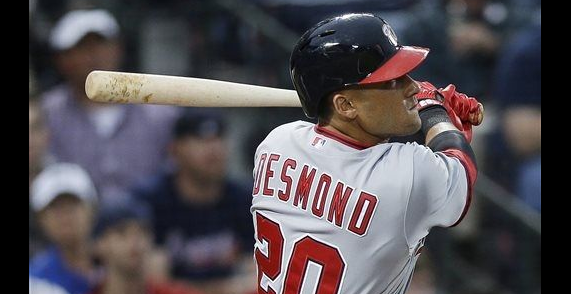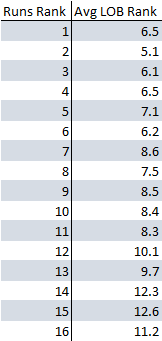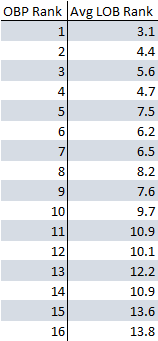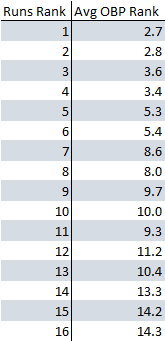Watching your team leave runners on base is insanely frustrating. After Thursday night’s loss, where the Nats only managed to score 3 runs while leaving 14 men on base, it’s easy to point at LOBs as a problem the Nats have to address.
But when you think about it, it certainly beats not getting guys on base at all, right? It can lead to elevated pitch counts, it makes you at least FEEL like you are getting to the pitcher… it’s just… different than not getting on base, even if the immediate results aren’t.
The next step in the logic would seem to be that if you leave a lot of guys on base, you probably get a lot of guys on base. And if you are doing that, you are probably also scoring a bunch of runs. But is that true?
I took a look at the NL rankings from 2004-2013 to take a stab at this question. That’s data from 159 teams (nine years of 16 teams in the NL, one year of 15). Rather than make this overly complicated, I looked at rankings – comparing where teams ranked in terms of number of runs scored, and where the ranked in terms of LOB. If my earlier hypothesis was correct, they should line up relatively well.
The chart below shows the average ranking of LOBs for ranking of runs scored (i.e. The average ranking of LOBs for the #1 run scoring teams, over the 10 years, was 6.5th)
So here is my interpretation of what this shows:
First, and most importantly, it does stratify in relatively logical groupings. The top 6 teams in runs scored end up being in a top grouping of LOBs, with their rankings ending up between 5.1 and 7.1. The middle teams, ranking 7-11 in runs scored, are in a middle group, averaging 7.5 to 8.6 in runners LOB. And the lowest 5 teams in terms of runs scored average a lower range of LOB, from 9.7 to 12.6.
Second, and probably almost as important, is that the stratification isn’t as disparate as one might think. The top teams in runs scored don’t even average top 5 in LOB, nobody does (although #2 came close). So while they are strongly correlated, it’s probably not quite enough to convince someone who was skeptical of the initial hypothesis. The teams that finish at the top in runs scored don’t always knock the most guys in per chance, the teams that finish at the bottom in runs scored sometimes end up leaving guys on base.
What I think this shows, though, is that LOBs are indeed a sign of runs being scored, but there’s going to be variation. In other words, over the course of 159 team seasons that we counted, some teams hit well with RISP and some didn’t. This is probably due to the luck associated with that magical act, more than anything else. A team that leaves a high number of men on base, though, is indeed indicative of a team that score a high number of runs.
Leaving men on base is a good indicator of runs scoring, over the course of a season, but it should really be a good indicator of getting guys on, right? I assume so, but lets take a look at OBP and LOB together. The chart below shows the average ranking of LOBs for each ranking of OBP in the NL:
This is a little closer to clear cut at first glance. The more you get on base, the more you leave on base. It’s not an exact match, but it’s pretty damn close. But why is getting on base so important – after all, it doesn’t necessarily means runs are scored, does?
Yeah, it does. Take a look at this chart. It compares the average ranking of OBP for each ranking of runs scored in the NL from 2004-2013.
Gives you a pretty good idea of why the sabermetric world loves OBP. It’s about as close to an exact match as you can get with these basic stats, before jumping in to things that require a regression analysis or squaring some sort of denominator.
My guess is if you were to increase this to 1,000 team seasons, or 5,000 of them, you’d find the correlation to be even stronger.
All this shows us that LOB are a function of teams getting on base, and scoring runs is a function of getting on base. The teams that get on base the most tend to score the most… and leave the most on base. Apologies if that doesn’t make watching the Nats leave guys on base any less painful.




